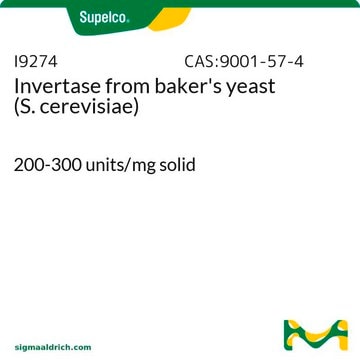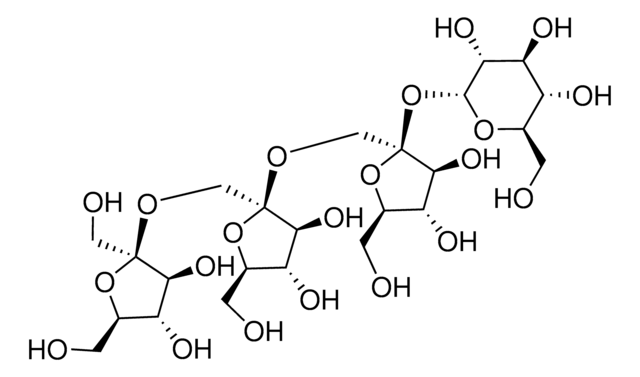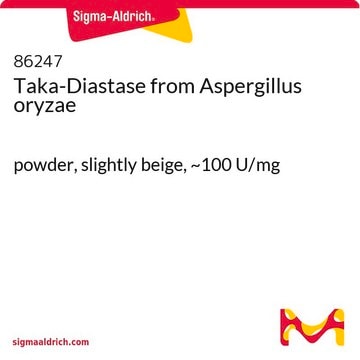57620
Inulinase from Aspergillus niger
lyophilized, powder, brown-gray, ~25 U/mg
Sign Into View Organizational & Contract Pricing
All Photos(1)
About This Item
Recommended Products
biological source
Aspergillus niger
form
powder
quality
lyophilized
specific activity
~25 U/mg
color
brown-gray
storage temp.
2-8°C
General description
Inulinases are classified as exoinulinases and endoinulinases.
Application
Inulinase from Aspergillus niger has been used as a glycoside hydrolase (GH) to study its potential to disperse bacteria (P. aeruginosa and S. aureus) from microbial biofilms using a polymicrobial well-plate model.
Biochem/physiol Actions
Inulinase is used in high-fructose syrup, which has therapeutic applications. Inulinase is reported to have high activity toward sucrose.
Inulinase hydrolyses inulin to produce oligosaccharides and liberate fructose. It also splits the terminal fructose units into sucrose and raffinose.
Unit Definition
1 U corresponds to the amount of enzyme which releases 1 μmol of reducing sugar (measured as fructose) per minute at pH 4.1 and 37°C from inulin
Other Notes
Characterization
Signal Word
Danger
Hazard Statements
Precautionary Statements
Hazard Classifications
Resp. Sens. 1
Storage Class Code
11 - Combustible Solids
WGK
WGK 1
Flash Point(F)
Not applicable
Flash Point(C)
Not applicable
Personal Protective Equipment
dust mask type N95 (US), Eyeshields, Gloves
Certificates of Analysis (COA)
Search for Certificates of Analysis (COA) by entering the products Lot/Batch Number. Lot and Batch Numbers can be found on a product’s label following the words ‘Lot’ or ‘Batch’.
Already Own This Product?
Find documentation for the products that you have recently purchased in the Document Library.
Customers Also Viewed
R. Azhari et al.
Biotechnology and Applied Biochemistry, 11, 105-105 (1989)
Homa Torabizadeh et al.
Applied biochemistry and biotechnology, 165(7-8), 1661-1673 (2011-10-01)
The structural and storage and functional thermostabilization of endo-inulinase (EC 3.2.1.7) through semi-rational modification of surface accessible lysine residues by pyridoxal-5'-phosphate (PLP) and ascorbate reduction have been explored. Improved stability was observed on modifications in the absence or presence of
Chun-Hai Zhao et al.
Bioresource technology, 102(10), 6128-6133 (2011-03-18)
In this study, it was found that the immobilized inulinase-producing cells of Pichia guilliermondii M-30 could produce 169.3 U/ml of inulinase activity while the free cells of the same yeast strain only produced 124.3 U/ml of inulinase activity within 48
Bo Yuan et al.
Applied microbiology and biotechnology, 96(6), 1517-1526 (2012-05-25)
A novel extracellular exoinulinase was purified and characterized from a new yeast strain KRF1(T), and the gene encoding the enzyme was successfully cloned. The enzyme was stable at low pH between 3.0 and 6.5. The K (m) and V (max)
Shuguang Yuan et al.
PloS one, 7(5), e37453-e37453 (2012-06-05)
Glycoside hydrolases of families 32 (GH32) and 68 (GH68) belong to clan GH-J, containing hydrolytic enzymes (sucrose/fructans as donor substrates) and fructosyltransferases (sucrose/fructans as donor and acceptor substrates). In GH32 members, some of the sugar substrates can also function as
Our team of scientists has experience in all areas of research including Life Science, Material Science, Chemical Synthesis, Chromatography, Analytical and many others.
Contact Technical Service













